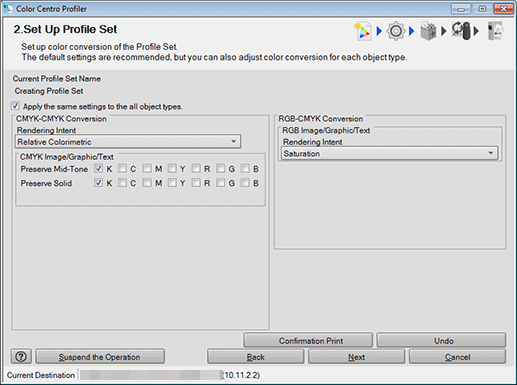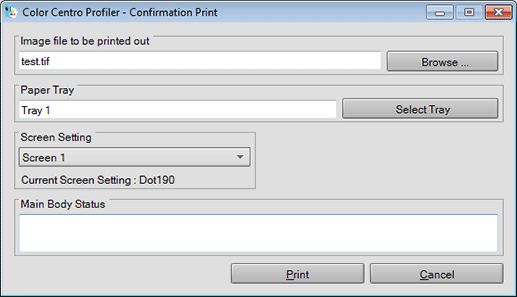
Configuring the Color Conversion Setting
In the Color Conversion Setting screen, you specify the following items:
Rendering intents for CMYK-CMYK conversion
Preserve Mid-Tone and Preserve Solid for CMYK objects (image, graphic, and text)
Rendering intents for RGB objects (image, graphic, and text)
Rendering intents are methods to convert color spaces.
From CMYK-CMYK Conversion - Rendering Intent, select the rendering intent.

supplementary explanationRelative Colorimetric is the setting to execute color conversion regarding the paper color as completely white. The paper color parts are represented as colorlessness after color conversion.
supplementary explanationAbsolute Colorimetric (Simulate Paper Color) is the setting to execute color conversion maintaining the measurement value of the paper color. The paper color parts are represented with the color near the actual paper color after color conversion. When you select Absolute Colorimetric (Simulate Paper Color), Preserve Mid-Tone and Preserve Solid (except for K) are not available.
supplementary explanationWhen you make all contents of the setting on the screen the same content as recommended setting, click Undo.
When you set the preserve mid-tone for one color, check Preserve Mid-Tone of that color.
supplementary explanationIf you check Apply the same settings to the all object types., you can apply the same settings to all images, graphics, and text.
supplementary explanationIf you remove the check from Apply the same settings to the all object types., you can apply the different settings to each of the object types, namely, images, graphics, and text.
supplementary explanationPreserve Mid-Tone is a setting to recompose the color after the color conversion as the same one color which has composed the color before the color conversion.
supplementary explanationThe setting of C, M, Y and K is the setting for the color composed of C/M/Y/K only.
supplementary explanationThe setting of R is the setting for the color composed of M and Y.
supplementary explanationThe setting of G is the setting for the color composed of C and Y.
supplementary explanationThe setting of B is the setting for the color composed of C and M.
supplementary explanationIn some cases, you cannot set Preserve Mid-Tone and Preserve Solid at the same time.
In Preserve Solid, check the color to which to apply Preserve Solid.
supplementary explanationIf you check Apply the same settings to the all object types., you can apply the same settings to all images, graphics, and text.
supplementary explanationIf you remove the check from Apply the same settings to the all object types., you can apply the different settings to each of the object types, namely, images, graphics, and text.
supplementary explanationPreserve Solid is a setting to represent the solid part after the color conversion with the same color which is used for the solid part before the color conversion.
supplementary explanationThe setting of C, M, Y, and K is the setting about the color composed of C/M/Y/K only.
supplementary explanationThe setting of R is the setting for the color composed of M and Y.
supplementary explanationThe setting of G is the setting for the color composed of C and Y.
supplementary explanationThe setting of B is the setting for the color composed of C and M.
supplementary explanationIn some cases, you cannot set Preserve Mid-Tone and Preserve Solid at the same time.
From RGB-CMYK Conversion - Rendering Intent, select the rendering intent.
supplementary explanationIf you check Apply the same settings to the all object types., you can apply the same settings to all images, graphics, and text.
supplementary explanationIf you remove the check from Apply the same settings to the all object types., you can apply the different settings to each of the object types, namely, images, graphics, and text.
supplementary explanationPerceptual is the recommended setting for Image objects. It enables color reproduction using colors close to those before the conversion.
The gradation is retained by compressing the whole data.
This option is suitable for photographs.
supplementary explanationSaturation is the recommended setting for Graphics objects and Text objects. It enables reproduction with colors retaining the vividness as close as possible to the colors before the conversion.
Color shades become more vivid by being converted closer to the high saturation area (the outside of the CMYK color gamut).
This option is suitable for presentation materials.
Click Confirmation Print for the test printing.
Confirmation Print screen appears.
Click Print for the test printing.

supplementary explanationClick Browse to display the screen to select the image for printing.
supplementary explanationClick Select Tray to display the screen to specify the tray used by confirmation printing.
supplementary explanationFrom Screen Setting, select the screen setting used by confirmation printing.
supplementary explanationWhen you click Cancel, Confirmation Print screen is closed to return to the Customize Color Conversions screen.
Confirm the result of test printing.
Click Next.
The Comment screen appears.
supplementary explanationGo to Calculating a Profile Set.